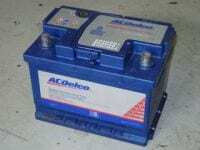Why batteries are often flat
Many classic cars are used so infrequently that the battery goes flat - a depressing experience to say the least!
 Lead acid batteries never fully recover from being flattened, and repeated flattenings render them useless. Several items in a car that run continuously even with the ignition off include the radio memory, the trip computer and the remote locking/alarm system. It makes no difference whether the car is locked or not – the alarm’s radio receiver is still listening out for a blip from your keyfob. These items will often flatten a good battery within 3 weeks. The maths:
Lead acid batteries never fully recover from being flattened, and repeated flattenings render them useless. Several items in a car that run continuously even with the ignition off include the radio memory, the trip computer and the remote locking/alarm system. It makes no difference whether the car is locked or not – the alarm’s radio receiver is still listening out for a blip from your keyfob. These items will often flatten a good battery within 3 weeks. The maths:
A typical new car battery has a capacity of 50amp hours – that is, it can supply 50amps for one hour, or 5 amps for 10 hours or 1 amp for 50 hours and so on. What’s an amp? Well, a pair of headlamps will draw about 10amps so they’d last 5 hours. The trip, radio and remote/alarm can take about 0.08amps so the battery would last around 625 hours or 26 days. This is for a new battery, fully charged.
To make things worse, most batteries seldom get fully charged as it takes at least over an hour of driving to charge a battery that’s nearly flat, and that’s only if the alternator isn’t having to supply a lot of power to headlamps, heaters, heated screens etc; so in the winter batteries get flatter from journey to journey for medium and short journeys.
What to do?
Well, the best solution is to connect a trickle charger whenever the car is to be left – this can be inconvenient but it keeps the car and its security system just as you left it – power available for the starter and remote locking enabled. One can also connect a solar charger, such as this placed in the windscreen or outside the garage. The solar cell must provide at least 100mA (0.1amps) in broad sunlight in order to provide enough charge to cover night time and cloudy days. It must also be waterproof if used outside!
Next best is a battery switch which can be fitted for around £50 including cutting an access panel in the battery cover. This guarantees the battery will be fine, but the radio and trip will lose their memories and the alarm & remote locking won’t be on.
Finally a split charging and twin battery system is ideal as it ensures there is always battery power for starting, and will keep everything else running for at least 2 weeks before switching ancillaries off. Cost is around £230.
We are working on a simplified switch system which turns off all ancillaries except the starter feed. This will have the same effect as the battery disconnect switch but be easier to use (you won’t need to open the boot) and cheaper than the split charging system.
A crude but simple get-out-of-trouble idea is to keep a spare, trickle-charged battery in the garage with a pair of heavy current jump leads. But remember that if the main car battery is allowed to go flat then it will progressively lose its capacity.
Also note that batteries lose some of their instantaneous power for starting when the weather is cold – worsened by the engine being stiffer to turn over. Even a good battery can struggle to start a V12 at -10deg C! A curious effect is that if the battery is cold but charged one can heat it up by turning on the headlamps, heaters and so on for a few minutes. It will then be more able to start the engine – but please note this is only sensible for a fully charged battery. If it’s nearly flat, this procedure will only make it worse…
Ok, your battery is flat - what to do to start it?
One can’t push-start most Jaguars because they mostly have automatic gearboxes – and they’re heavy!
Jump starting from another car is fine, but starting a cold V12 may well be beyond another small car. At least make sure the starter car is running so you don’t flatten it and you have two stuck cars! Use heavy current, thick jump leads. Cheap thin ones can’t carry enough current and the clip connections often fail – and can burn.
Jump starting from a spare battery is fine.
Putting the car on charge with a decent charger (at least 8 amps output) is good but it will take at least half an hour to get enough charge in.
A portable booster pack is good although it will need to be a big one such as this .
We advise against mains boosters – domestic ones aren’t big enough to start a Jaguar engine and industrial ones produce a voltage much higher than 12v initially and so will damage the engine computer and most other electronic devices.
If you found this article helpful please hit the like button below to let us and others know.
